Wagon Reviews
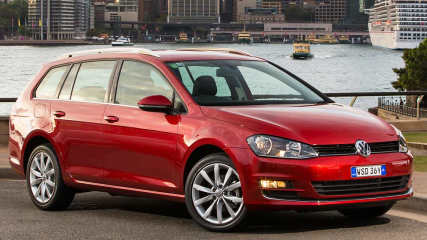
Volkswagen Golf Highline 2014 Review
Read the article
By Chris Riley · 24 Jul 2014
Chris Riley road tests and reviews the Volkswagen Golf wagon 103 TSI, with specs, fuel consumption and verdict.
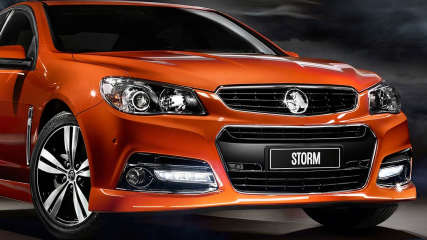
Holden Commodore SS Storm 2014 review
Read the article
By Chris Riley · 24 Jul 2014
Chris Riley road tests and reviews the Holden SS Storm Sportwagon, with specs, fuel consumption and verdict.
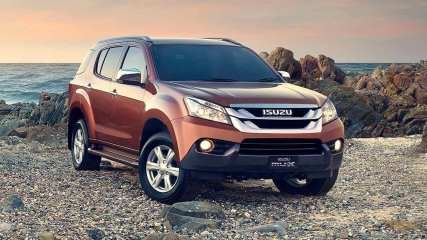
Isuzu MU-X LS-T 2014 review
Read the article
By Aiden Taylor · 21 Jul 2014
Aiden Taylor road tests and reviews the 2014 Isuzu MU-X 4WD LS-T with specs, fuel consumption and verdict.
-d.jpg)
Mercedes-Benz C-Class 2015 Review
Read the article
By Joshua Dowling · 21 Jul 2014
Mercedes-Benz C-Class wagon is the SUV you have when you don't want an SUV.A year's supply of wine for 75 people fits in the back of the new Mercedes-Benz C Class wagon -- if you fold down the back seats and, erm, line the inside with waterproof material and pour the contents out of the bottles. Car makers measure cargo volume in litres, rather than what we actually carry: boxes, luggage, prams, or shopping bags that are prone to fall over after the first speed bump. They use this internationally recognised measurement so they can include every nook and cranny in the cargo hold to boost the figures that appear in the brochure. This unusual statistic -- enough wine for 75 people who each drink an average of 20 litres of plonk per year -- was read aloud on the navigation system as we drove soberly through wine country on the outskirts of Frankfurt, Germany. Car makers clearly don't miss an opportunity to make a point, presumably in case you were asleep during the presentation. At least they can (hopefully) count on you being awake behind the wheel. For me, though, the biggest point about this car -- the wagon version of the recently released Mercedes-Benz C Class sedan -- is the fact that this is the SUV you have when you don't want an SUV. While car buyers around the world are still gorging themselves on SUVs, some have already started a backlash. The C Class offers SUV-like versatility with its large load space, and yet is more fuel-efficient than a faux-wheel-drive. Its sleek design means it slips through the air more easily and therefore uses less fuel, especially at freeway speeds. In Germany, wagons are seen as cool as -- if not cooler than -- SUVs. Up to 80 per cent of Mercedes-Benz C Class sales are of the wagon. That is not a misprint. Eighty per cent. In Australia, wagons are still perceived as daggy, a hang over from a generation that grew up with Kingswood and Falcon wagons. Which partly explains why less than 10 per cent of all C Class models sold locally are wagons. But with its sexy new design, Mercedes hopes this car will change all that. Boldly, it predicts it will double C Class wagon sales Down Under. Are they onto something, or have they been to too many tastings? VALUE The Mercedes-Benz C Class sedan is already one of the best-equipped and sharpest-priced cars among its luxury peers, and the wagon is no exception. The wagon premium is just $2500 over the sedan, which gives you a starting price of $63,400 plus on-road costs. Significantly, that's about $10,000 less than some of the most popular luxury SUVs, including Mercedes' own. Standard fare includes eight airbags, LED headlights (for a brighter, broader beam), a rear view camera and a tailgate that opens or closes with the touch of a button. Opening the tailgate with a deft swing of your foot under the rear bumper (as some Fords and Volkswagens also do, the idea is that you can briefly stand one-legged and motion to open the tailgate with one foot rather than fumble for the remote key if your hands are full) is exclusive to the dearer C Class wagon models. There will be four from which to choose when the C Class wagon goes on sale in Australia later this year priced from $63,400 to $72,900: a C200 and C250 petrol (the same 2.0-litre turbo engine but with distinctly different power outputs) and a C200 and C250 diesel (with 1.6- and 2.2-litre turbo diesel engines respectively). All are matched to seven-speed automatic transmissions (although these will be updated to nine-speed automatics at the half-way mark of the car's model cycle, in about four years). The service intervals for all models are 12 months or 25,000km (whichever comes first) but the cost is anyone's guess. As with all luxury brands, Mercedes-Benz (and others) are yet to offer the peace of mind of capped price servicing, as offered by all the Top 10 brands and some others. TECHNOLOGY You can change the way this car feels to drive, depending on your mood. There are four different modes -- all changed at the press of one button -- that transform the steering feel, the responsiveness of the transmission, and whether you want the air-conditioning to chill you at all costs, or save a little fuel on milder days. It's brilliant in its simplicity, and it means you can choose between being a “hyper miler” (car industry slang for professional drivers who win fuel economy challenges), getting pampered in the most comfortable setting as possible, or choosing a sports mode that makes the car more responsive. Customarily, when there is such a vast choice, there is usually only one, maybe two good settings -- and more than a couple of dud ones. But they all work in this car. You can even mix and match the various parameters (ie: light steering, sharp throttle response, eco air-conditioning). For the record, after experimenting with them all, I left it in “normal”. Other neat stuff: automatic emergency braking is standard on all Mercedes-Benz C Class sedans and wagons. In traffic below 50km/h it will slam on the brakes and avoid the car in front if you're not concentrating. DESIGN Wow. That's the reaction from most people when they see it for the first time. Wagons aren't supposed to look this good. The new C Class has set a pretty tough challenge for anyone who wants to design a wagon from this point on. The excuse that they need to look like a box to carry lots of boxes no longer applies. Although the roof appears to taper at the back and the cargo bay looks smaller (from the outside at least) the Mercedes-Benz C Class does, in fact, have a bigger cargo area than its peers. Vital statistics in litres, with the back seat up and with the back seat down: Audi A4 wagon (490/1430L), BMW 3 Series wagon (495/1500L), and the Mercedes-Benz C Class wagon (490/1510L). SAFELY Eight airbags, automatic emergency braking, and one of the most advanced stability control systems on the market (that prevents skidding in corners if you're a touch too quick on a slippery road) give the C Class a solid five-star ANCAP safety score. Other technology from the top-line, $200,000 S-Class limousine has also trickled down: lane keeping alert, blind zone alert, fatigue alert, and an extra pre-tensioner for the seat belt pre-tensioners (it anticipates a crash and takes up the slack in the seatbelt before impact, before the pre-tensioners are properly deployed and tightened again as the airbags fire) are just some of the highlights. It's a jumping castle on four wheels. DRIVING It's really hard to write car reviews about modern wagons. Back in the day, not long after humans learned to walk on two legs, wagons were bloody awful to drive. Their heavy rear ends felt like a dog dragging its hind legs along the grass to scratch an itch. There was a stark contrast between how sedans and wagons drove. But today's wagons feel as good if not better to drive than the sedans on which they are based. Indeed, the only way you can tell this is a wagon is when you glance in the rear view mirror, to check the traffic and, presumably, to make sure there's no wine sloshing around. Why is it so? Well, engineers have gotten smarter and have more technology available to them. And they understand how to make structures stronger yet lighter, both of which, in turn, help how a car behaves on the road. If you count the number of metal pillars holding the roof up, most sedans have six and wagons have eight (two extra ones at the back, either side of the tail-gate). It means that wagon bodies are, in fact, stronger than sedans, now that the whole design is integrated, rather than an afterthought. And it means the people who finesse the suspension have a good core to work from. Anyone who has done Pilates or Yoga should relate to this because it is exactly the same principle: get the core right and the limbs (or in this case the suspension) can do their work more efficiently and more effectively. Meanwhile, under the bonnet, the petrol engines are the pick for various reasons. The petrol engines help the steering feel a little lighter and more precise because the engines themselves physically weigh less than the diesel engines. The diesel engines tend to blunt the steering feel and responsiveness. The petrol engines in this car are also smoother and quieter in the way they operate. The diesels are entirely acceptable by luxury car standards but unless you're covering massive kilometres at freeway speeds, the petrol engines are now so efficient, they're definitely the better choice. Both engine types can sound a little coarse when accelerating in a hurry, but so do all engines. It's hardly a deal breaker.
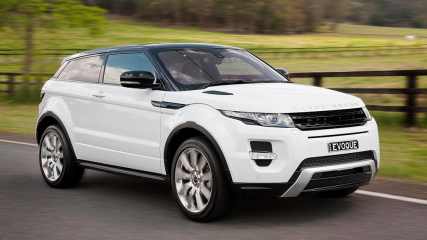
Used Land Rover Range Rover Evoque review: 2011-2013
Read the article
By Graham Smith · 18 Jul 2014
NEW In a sea of unrelenting sameness the Range Rover Evoque stands out with its super low roofline giving it a sporty style unlike any other SUV. But it's not just about the look of the Evoque, it's also a capable vehicle on and off road, as you would expect from such a respected brand in the off-road field. Like all
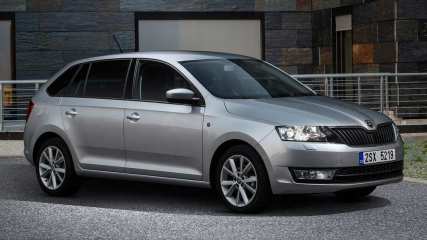
Skoda Rapid 2014 Review
Read the article
By Peter Barnwell · 15 Jul 2014
Peter Barnwell road tests and reviews the 2014 Skoda Rapid 90 TSI, with specs, fuel consumption and verdict.

Toyota Kluger Grande 2014 review
Read the article
By Ewan Kennedy · 07 Jul 2014
Ewan Kennedy road tests and reviews the Toyota Kluger GX with specs, fuel consumption and verdict.

Used Daihatsu Terios review: 1997-2005
Read the article
By Ewan Kennedy · 02 Jul 2014
Daihatsu's tiny Terios was never a huge seller in Australia, possibly because was considered too small for its tough-guy market segment, but did steady business from the time it went on sale here in 1997 until its withdrawal in 2005. Daihatsu is one of the world leaders in small-vehicle design and has long had a
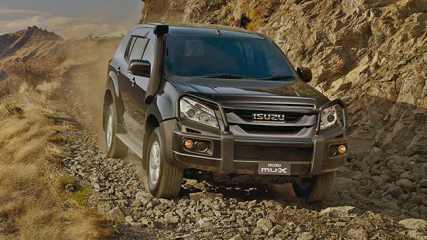
Isuzu MU-X LS-T 2014 review: snapshot
Read the article
By Neil Dowling · 30 Jun 2014
For those who really want to go bush, the vehicle options are dwindling. Yet the family-friendly, seven-seat Isuzu MU-X is one of the big surprises - eminently capable in the dirt, very comfortable in the city, fuel efficient, durable and, it could be said, good looking. But it's not for pretenders.There are three models and two transmissions and, though based on the Holden Colorado 7, there are important differences. The Isuzu has fewer kilowatts and one cog less in the automatic transmission than the Colorado, but has a superior five-year warranty, is more economical, has a full-size spare wheel and in the $53,500 LS-T model, a rear DVD player.The excellent iGo satnav, eight-speaker audio (but no Bluetooth audio streaming), reverse camera, aircon in all three rows, leather upholstery and electric driver's seat are all standard. There's no capped-price service and servicing is six-monthly. The LS-T tested is expensive and $49,300 LS-U is better value.The Thai-built wagon is a good looker. The "happy face" nose and the neat side profile with blackened rear-side and rear glass cleverly shrink the MU-X's proportions. The wagon is high off the ground but side steps give good access to the third seat row via a split, fold and tumble second row.The cargo floor is high — courtesy of the bulky live-axle rear and coil suspension — and interrupted by a box containing the luggage blind. Space is 235 litres (all seats up) to 1830 litres. The third row of seats folds flat but the tumble-fold second row reduces the boot floor length.Top marks for the rooftop vents for all rear passengers, two gloveboxes and dash top-box, grab handles, cupholders, storage space and lap-sash seat belts for all seven occupants.The MU-X ("Mysterious Utility" is how SUV translates in Thai) dispenses with the Isuzu D-Max dual-cab ute's live rear axle and leaf springs, bolting in a long-travel coil spring arrangement. The 3.0-litre turbo diesel (130kW/380Nm) and the Aisin five-cog auto are not shared with Holden's products. There are disc brakes all-round and two big skid plates, it's relatively light at 2060kg yet has a 3000kg tow rating.Despite its truck origins, it gets a five-star crash rating, six airbags, rear camera, rear park sensors, hill holder, electronic stability and traction control, full-size alloy spare and brake assist. Hill descent is automatic and built into the gearbox's sensors, though isn't as effective as a switchable system.I expected a truck and happily realised this is something between a 4WD ute and a Toyota Kluger. It is a confident cruiser and sits solidly on the road and is barely affected by sidewinds or rutted bitumen. The engine is torquey and forgiving — more docile and feels more powerful than the Colorado — with surprising economy. An electric switch controls the two-speed transfer case.Gravel and sand failed to slow this wagon and the high ground clearance and long-travel rear suspension made short work of washouts. The turning circle is large — typical of the genre — which can frustrate city owners. Good ride comfort over rough terrain and quiet highway cruising makes it one of the better all-rounders.

Volvo V60 2014 Review
Read the article
By Paul Gover · 27 Jun 2014
Paul Gover road tests and reviews the Volvo V60 Drive-E T5 R-Design, with specs, fuel consumption and verdict.




